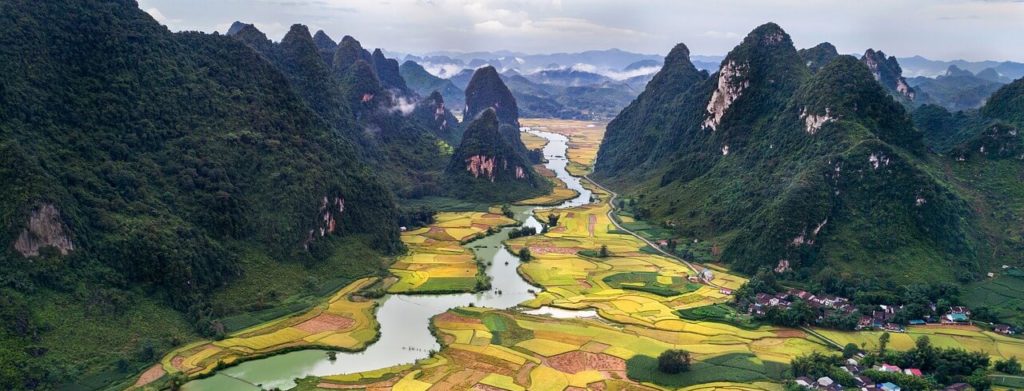The endorsement of the Guidelines by the region’s ministers of agriculture and forestry paves the way for implementation to restore degraded landscapes, improve food security and livelihoods, enhance farmers’ resilience and meet nationally determined contributions to climate-change targets.
The ASEAN Ministers on Agriculture and Forestry held their 40th meeting on 11 October 2018 in Ha Noi, Viet Nam, under the Chairmanship of H.E. Nguyen Xuan Cuong, Minister of Ministry of Agriculture and Rural Development of Viet Nam. At the meeting, the ministers endorsed the ASEAN Guidelines for Agroforestry Development to promote the role of agroforestry in simultaneously achieving economic, environmental and social outcomes at farm, household and landscape levels and help ASEAN Member States achieve their targets related to food security, sustainable growth, reduction of greenhouse-gas emissions, land restoration, watershed protection, gender equality, social/community forestry, climate-change adaptation and mitigation and, more generally, the Sustainable Development Goals.
The ASEAN Senior Officials of Forestry have correspondingly commissioned a curriculum for training of trainers in agroforestry and an agroforestry practitioners’ field guide to be prepared in English for translation into languages of the Member States in the region of 650 million people. The Guidelines are supported by a series of ASEAN agroforestry policy briefs in several languages, with more briefs in development.
Several Member States have already started work on implementing the Guidelines. Both Cambodia and Myanmar are setting out ‘road maps’ for agroforestry development that draw on the lessons in the Guidelines. Based on experience in the two countries, the ASEAN Secretariat has requested a template for creating such road maps that can be used by Member States to ease the process of agroforestry development.
In parallel developments, the work of the national working group on agroforestry in Viet Nam was partly inspired by the process that led to the Guidelines. The working group is particularly focusing on agroforestry’s contributions to the country’s nationally determined contributions to reduce greenhouse-gas emissions under the United Nations Framework Convention on Climate Change. In the Philippines, a process has begun to develop a national agroforestry policy or similar guiding document, similarly inspired by the Guidelines process, which has begun to raise general awareness of the benefits of agroforestry across the region, particularly, among governments and farmers.
The Guidelines grew out of the work of the ASEAN Social Forestry Network, which later transformed into the formally endorsed ASEAN Working Group on Social Forestry. The Working Group consists of delegates from Member States’ ministries responsible for social or community forestry. It has been supported over ten years by the ASEAN-Swiss Partnership on Social Forestry and Climate Change, with generous, prescient funding and guidance from the Swiss Development Cooperation Agency.
The Partnership provided a secretariat to support the Working Group along with a range of technical partners who provided evidence and recommendations on field development and policies for social forestry, which increasingly recognized the critical role that agroforestry could play in not only protecting natural forests from increasing demand but, importantly, improving the livelihoods of farmers living on forest margins, providing many of the ecosystem services that forests had provided more widely in the past, and helping both farmers and governments adapt to, and mitigate, climate change.
Technical partners included World Agroforestry (ICRAF), Center for International Forestry Research, RECOFTC The Center for People and Forests, Non-Timber Forest Products Exchange Programme and the Southeast Asian Regional Center for Graduate Study and Research in Agriculture.
After a call for an ‘ASEAN agroforestry strategy’ in 2014 and the inclusion of agroforestry in the Vision and Plan for ASEAN Cooperation in Food, Agriculture and Forestry 2016–2025 that was endorsed by the 38th ASEAN Ministers of Agriculture and Forestry meeting in 2016, the 20th ASEAN Senior Officials of Forestry meeting agreed to develop ASEAN guidelines on agroforestry, prompting the ASEAN Secretariat to call on the Partnership’s technical partners, led by ICRAF, to draft the guidelines, which began in late 2016.
In early 2017, a draft was bolstered with inputs from the inaugural meeting of the Mekong Expert Group on Agroforestry for Food and Nutrition Security, Sustainable Agriculture and Land Restoration, which was supported by the Swedish International Agriculture Network Initiative, SIANI and input from the Food and Agriculture Organization of the United Nations. The text was subsequently circulated among Member States’ forestry agencies, non-governmental organizations, farmers’ associations, the private sector and other interested parties for further input.
A draft ready for endorsement was presented to the regional conference, Harnessing the Potential of Agroforestry for a Prosperous and Resilient ASEAN, held in Da Nang, Viet Nam on 26 June 2018.
The next day, the draft was endorsed by the 12th annual meeting of the ASEAN Working Group on Social Forestry and then at the 21st Meeting of the ASEAN Senior Officials of Forestry held in Nay Pyi Taw, Myanmar on 12 July 2018. The document was circulated to agriculture ministries in Member States for their input before final approval by the ministers of agriculture and forestry in Ha Noi.
The Guidelines outline 14 principles accompanied by 74 guidelines and five implementation considerations. While voluntary for Member States, endorsement by the ministers indicates strong political will for implementation.
This article was originally published by Rob Finlayson at World Agroforestry Blog.
